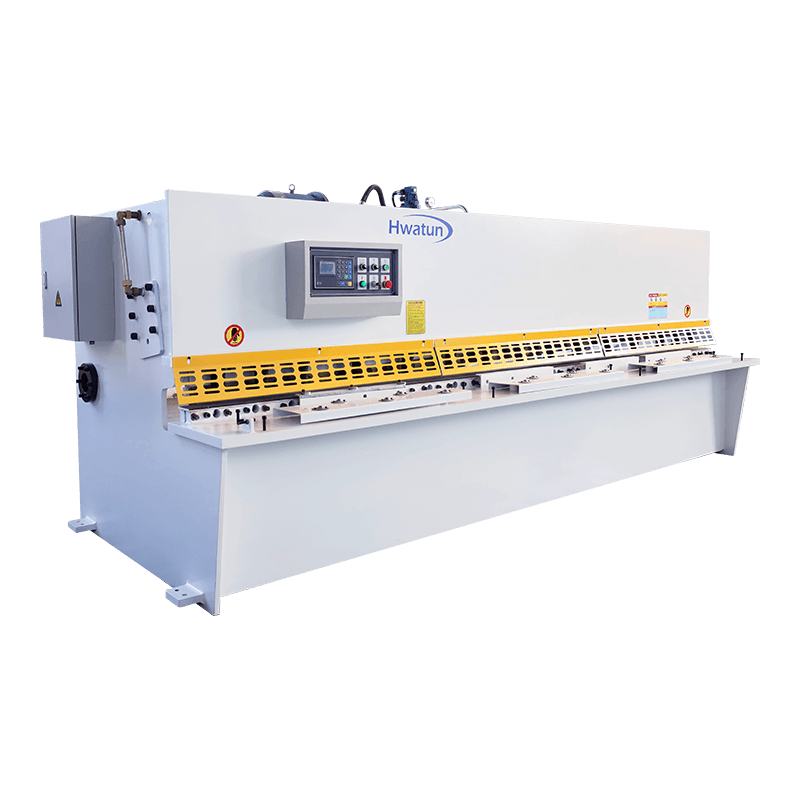Web Menu
Product Search
Exit Menu
How to perform routine maintenance to extend the service life of SHEARING MACHINE?
In order to extend the service life of the shearing machine and ensure its efficient and safe operation, daily maintenance is essential. Through regular inspection, cleaning and maintenance, the incidence of equipment failure can be reduced, production efficiency can be improved and maintenance costs can be reduced. The following are detailed daily maintenance methods:
Inspection before daily operation
Blade inspection:
Check whether the blade is sharp, cracked or worn. If the blade is found to be blunt or damaged, it should be replaced in time.
Ensure that the blade gap is properly adjusted. Too large a gap will cause uneven shearing, while too small a gap may increase blade wear.
Lubrication system:
Check whether there is enough lubricant in the lubrication points (such as gears, bearings and sliding parts). Refill or replace the lubricant as needed.
Use the appropriate type of lubricant and avoid using inferior or incompatible lubricants.
Work surface cleaning:
Clean metal debris or other debris on the work surface to prevent these debris from affecting the shearing accuracy or damaging the equipment.
Electrical system inspection:
Check whether the power connection is firm and whether the cable is damaged or aging.
Test whether the emergency stop button and other safety devices are working properly.
Weekly regular maintenance
Transmission system inspection:
Check whether the transmission chain, belt or gear is loose, worn or has abnormal noise. If there is any problem, adjust or replace it in time.
Hydraulic system (applicable to hydraulic shearing machine):
Check the level and quality of hydraulic oil, and replenish or replace hydraulic oil if necessary.
Check whether the hydraulic pipeline is leaking or blocked to ensure that the system pressure is stable.
Blade alignment correction:

Check the alignment of the blade regularly to ensure that the parallelism and clearance between the upper and lower blades meet the requirements.
Cooling system (if any):
Check the level and cleanliness of the coolant to prevent equipment damage due to overheating.
Monthly deep maintenance
Comprehensive cleaning:
Cleaning the equipment thoroughly, especially the hard-to-reach parts (such as internal transmission mechanism, slide rails, etc.).
Use compressed air to blow away dust and debris to avoid accumulation that affects equipment performance.
Bearing inspection and lubrication:
Check the operating status of all bearings to ensure that there is no abnormal noise or heat.
Regularly add or replace bearing grease according to the requirements of the equipment manual.
Electrical control system test: Check whether the indicator lights, buttons and display screens on the control panel are working properly. Test the functions of limit switches, sensors and encoders to ensure that they are sensitive and reliable. Quarterly professional maintenance Blade replacement and trimming: If the blade is severely worn or loses its sharpness, it should be replaced or trimmed. Use professional sharpening tools to repair the blade and restore its shearing performance. Mechanical component calibration: Calibrate the key mechanical components of the shearing machine (such as blade position, shearing angle, etc.) to ensure that their accuracy meets the requirements. Hydraulic system in-depth inspection: Check the status of the hydraulic pump, valve body and seals, and replace damaged parts if necessary. Clean the hydraulic oil filter to ensure that the oil circuit is unobstructed. Annual overhaul and evaluation Comprehensive disassembly and inspection: Disassemble the shearing machine and check the wear of all key components. Replace parts that have reached the end of their service life (such as bearings, seals, blades, etc.). Performance test: After reassembly, the shearing machine is tested for performance, including shearing accuracy, speed and load capacity. Record maintenance data:
Record the time, content and problems found in each maintenance to provide a basis for subsequent analysis and improvement.
Through the above daily maintenance measures, the service life of the shearing machine can be significantly extended, while improving its working efficiency and safety. The key to maintenance is preventive inspection and timely handling of potential problems, rather than waiting until the equipment fails before repairing. In addition, establishing a complete maintenance record and regular inspection plan will help better track the status of the equipment and optimize the maintenance strategy.
News categories
Product categories
Related Products
 +86-159 5138 1316
+86-159 5138 1316 +86 180 6819 3096
+86 180 6819 3096 [email protected]
[email protected] Group 4, Xinba Village, Binhai New Area (jiaoxie Town), Laoba Port, Nantong City, Jiangsu, China.
Group 4, Xinba Village, Binhai New Area (jiaoxie Town), Laoba Port, Nantong City, Jiangsu, China.
Copyright © Nantong Hwatun Heavy Machine Tool Co., Ltd. All Rights Reserved.

 Eng
Eng  简体中文
简体中文 Español
Español русский
русский







